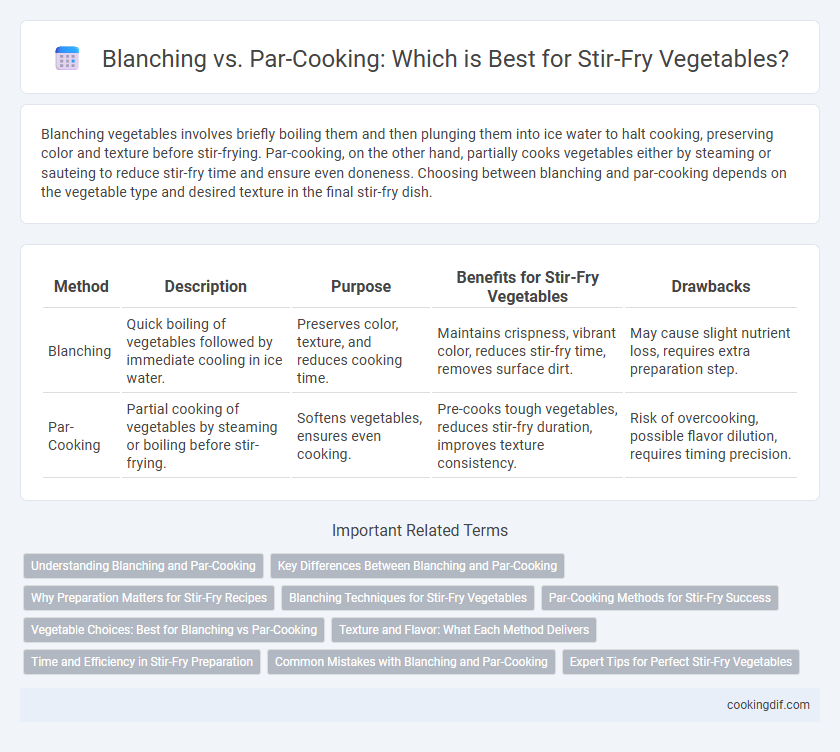Blanching vegetables involves briefly boiling them and then plunging them into ice water to halt cooking, preserving color and texture before stir-frying. Par-cooking, on the other hand, partially cooks vegetables either by steaming or sauteing to reduce stir-fry time and ensure even doneness. Choosing between blanching and par-cooking depends on the vegetable type and desired texture in the final stir-fry dish.
Table of Comparison
| Method | Description | Purpose | Benefits for Stir-Fry Vegetables | Drawbacks |
|---|---|---|---|---|
| Blanching | Quick boiling of vegetables followed by immediate cooling in ice water. | Preserves color, texture, and reduces cooking time. | Maintains crispness, vibrant color, reduces stir-fry time, removes surface dirt. | May cause slight nutrient loss, requires extra preparation step. |
| Par-Cooking | Partial cooking of vegetables by steaming or boiling before stir-frying. | Softens vegetables, ensures even cooking. | Pre-cooks tough vegetables, reduces stir-fry duration, improves texture consistency. | Risk of overcooking, possible flavor dilution, requires timing precision. |
Understanding Blanching and Par-Cooking
Blanching involves briefly boiling vegetables followed by rapid cooling in ice water to preserve color, texture, and nutrients, making it ideal for stir-fry preparation. Par-cooking partially cooks vegetables to a desired firmness without fully softening them, ensuring even cooking during the final stir-fry process. Understanding the distinction enables precise control over vegetable texture and enhances flavor retention in stir-fried dishes.
Key Differences Between Blanching and Par-Cooking
Blanching involves briefly boiling vegetables followed by immediate cooling in ice water to halt the cooking process, preserving color and texture. Par-cooking partially cooks vegetables to reduce total stir-fry time while maintaining a slightly firmer texture. Unlike blanching, par-cooking does not require ice baths and is primarily focused on speeding up the final cooking process.
Why Preparation Matters for Stir-Fry Recipes
Blanching preserves the vibrant color and crisp texture of vegetables by briefly boiling them before plunging into ice water, preventing overcooking during stir-frying. Par-cooking partially cooks vegetables, ensuring even heat distribution and reducing final stir-fry cooking time while maintaining freshness. Proper preparation enhances nutrient retention, flavor complexity, and overall dish quality in stir-fry recipes.
Blanching Techniques for Stir-Fry Vegetables
Blanching involves briefly boiling vegetables then plunging them into ice water to halt cooking, preserving vibrant color and crisp texture ideal for stir-fry dishes. This technique enhances the vegetables' natural flavors while maintaining nutritional value and reducing overall stir-fry cooking time. Proper blanching prevents sogginess and ensures even cooking, resulting in a balanced and appealing vegetable stir-fry.
Par-Cooking Methods for Stir-Fry Success
Par-cooking vegetables for stir-fry involves partially cooking them through methods like blanching, steaming, or microwaving to maintain crispness and vibrant color while ensuring even cooking during the final stir-fry. Blanching briefly immerses vegetables in boiling water, then shocks them in ice water to halt cooking, preserving texture and nutrients. Steaming retains more vitamins and flavor, making it a preferred par-cooking technique for stir-fry vegetables such as broccoli, snap peas, and carrots.
Vegetable Choices: Best for Blanching vs Par-Cooking
Vegetables with dense textures and high water content like broccoli, green beans, and carrots are ideal for blanching, as this process preserves color, nutrients, and crispness before stir-frying. Softer vegetables such as bell peppers, mushrooms, and zucchini benefit from par-cooking, allowing them to cook evenly without becoming mushy in the final stir-fry. Selecting the appropriate pre-cooking method based on vegetable type ensures optimal texture and flavor in the dish.
Texture and Flavor: What Each Method Delivers
Blanching vegetables briefly cooks them in boiling water, preserving vibrant color and crisp-tender texture while slightly mellowing raw flavors. Par-cooking, often done by steaming or light sauteing, softens vegetables more thoroughly and enhances natural sweetness, preparing them for final stir-fry crispness. Choosing between blanching and par-cooking impacts the balance of texture and flavor in stir-fry dishes, influencing overall mouthfeel and taste intensity.
Time and Efficiency in Stir-Fry Preparation
Blanching vegetables before stir-frying significantly reduces cooking time by partially cooking them in boiling water, ensuring even heat penetration without compromising texture. Par-cooking involves lightly cooking vegetables in steam or microwave to soften them, offering faster prep with minimal nutrient loss and enhanced efficiency during high-volume stir-fry production. Choosing blanching or par-cooking depends on vegetable type and desired final texture, both methods optimizing overall stir-fry workflow.
Common Mistakes with Blanching and Par-Cooking
Blanching often causes common mistakes like overcooking, which results in mushy vegetables and loss of nutrients, while undercooking leaves them tough and unevenly textured. Par-cooking errors include inconsistent heat application, causing vegetables to be partially raw or overly soft when stir-fried. Proper timing and immediate cooling after blanching, along with precise control of par-cooking duration, are essential to retain optimal texture and flavor in stir-fry vegetables.
Expert Tips for Perfect Stir-Fry Vegetables
Blanching vegetables before stir-frying ensures they maintain vibrant color and a crisp-tender texture by briefly boiling and rapidly cooling them, which also reduces overall cooking time. Par-cooking, involving partial cooking techniques such as steaming or microwaving, softens vegetables just enough to achieve even stir-frying without overcooking or burning. Expert tips recommend blanching denser vegetables like broccoli or carrots and par-cooking softer varieties like bell peppers to achieve balanced texture and maximize flavor in stir-fry dishes.
Blanching vs par-cooking for vegetables Infographic

 cookingdif.com
cookingdif.com